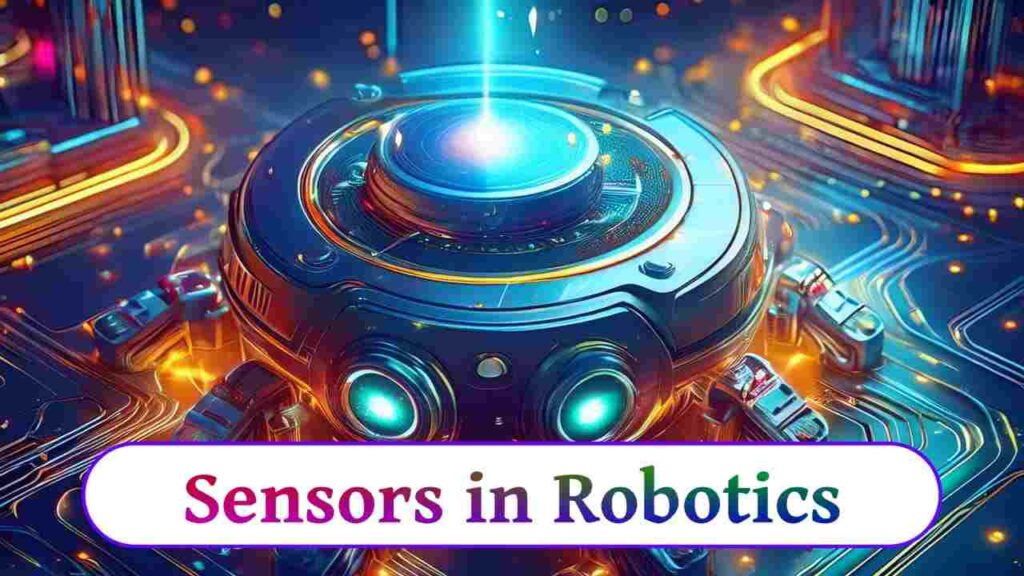Imagine a world where robots can feel, see, and even hear—just like us. It sounds like science fiction, right? Well, this isn’t just science fiction anymore. We’re already living in that world.

Today, robots are able to respond according to their environment. With the help of sensors, robots can perform different tasks. Just as our senses help us understand the world, sensors also allow robots to perform different tasks.
In this article, we are going to explore the different types of sensors in robotics. We will also delve into the applications of sensors in robotics. By the end of this article, you’ll be able to understand why sensors are the key to unlocking the full potential of robots.
Types of Sensors in Robotics
As we depend on different senses, robots also rely on various sensors. We will discuss each of these sensors one by one.
Force Sensors in Robotics
Humans can determine how much force should be applied to different tasks or objects through their experience. But what about robots? How can they know how much force should be applied to different tasks or objects? Here come force sensors.
Force sensors help robots measure how much force should be exerted on objects. It can measure how much pressure should be applied depending on the various situations of objects.
How force sensors are used in robotics
There are many use cases for force sensors in robotics.
- Force sensors are used in the assembly line to detect how much force should be applied to assemble products.
- In surgery, force sensors are used for the precise movements of surgical robots.
- This type of sensor helps robots detect and prevent unexpected collisions..
Torque Sensors in Robotics
We can rotate our heads as we wish, right? But how does a robot turn its head? Torque sensors help robots to do that.
Torque sensors can measure how much rotational force, or torque, should be applied to an object. But how do torque sensors work?
How do torque sensors work
- Torque sensors ensure that each joint of the robotic arms can move correctly. It prevents robots from over-rotation and potential damage.
- It helps to measure engine performance.
- This type of sensor also makes sure that bolts are tightened to their correct specifications. It prevents over-tightening or under-tightening. In this way, it prevents product failures.
Proximity Sensors in Robotics
Well, we can see through our eyes. By seeing, we can say if there is an object or not. But what about robots? How can a robot sense the presence or absence of any object without touching it?
Proximity sensors can help you in this situation. Proximity sensors can detect the presence or absence of any objects or obstacles without physical contact. It allows robots to navigate and interact with their environment efficiently..
How do proximity sensors work
- Proximity sensors can detect objects emitting electromagnetic waves and infrared waves.
- By using this type of sensor, we can determine if there are any objects within a specific range, from a few millimetres to several metres, depending on the type of sensor used.
- It helps robots to navigate by detecting obstacles on their path. It prevents collision.
Temperature Sensors in Robotics
Temperature sensors help robots measure the heat levels of any environment or object. It allows robots to function effectively by monitoring thermal conditions.
How do temperature sensors work
- Temperature sensors are used to keep track of the internal temperature of robots. It prevents overheating and assures longevity.
- This type of sensor helps robots adjust their behaviour based on the temperature of their environment. In various conditions, it assists robots to perform in their optimal positions.
- By detecting abnormal temperature spikes, it can alert the robot systems, preventing potential accidents.
Touch Sensors in Robotics
We humans can feel if something touches us through our skin. But how can a robot know if something touches it? How can a robot feel if it touches something? The answer is “touch sensors”.
Touch sensors are also known as tactile sensors. By detecting physical contact and pressure, it allows robots to feel their environment as our human skin does. Here are some examples of how touch sensors work:
How do touch sensors work
- Touch sensors can help robots understand the texture and shape of objects.
- This type of sensor can measure how much force is applied to any object.
- Touch sensors are used to adjust the grip strength of robots. So that it doesn’t cause any damage to a product.
Characteristics of Sensors in Robotics
Sensors in robots are like the nervous system in humans. It helps robots perceive and interact with their environment. Here are some key characteristics of sensors in robotics:
Sensitivity
Sensors should have the ability to detect even the slightest changes in their environment. For example, a force sensor needs to sense a few variations in pressure to handle smooth objects without damaging them.
Range
We all have a limit on what we can see in a certain area. In the same way, a robot has a limit on how far it can detect or measure. For example, a proximity sensor might have a range of a few centimetres to several metres.
Accuracy
Just as doctors depend on precise measurements for diagnosis, robots depend on sensors to provide exact data to make decisions. For example, a temperature sensor should measure heat accurately to avoid overheating.
Durability
Durability is one of the key characteristics of sensors in robotics. Sensors should have that resistance power for extreme temperatures or physical wear.
Response Time
What makes a robot better than another robot? Its response time. How fast a robot can give its feedback in a changing environment shows how efficient a robot is. In always-changing environments like assembly lines, quick response is essential for smooth operations.
Conclusion
Sensors are the only thing that makes a robot powerful. Without these, robots are as useless as a vehicle without an engine.









